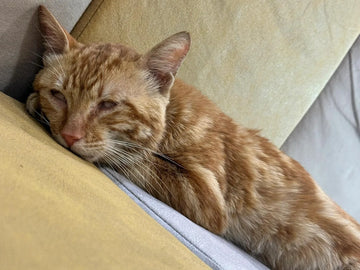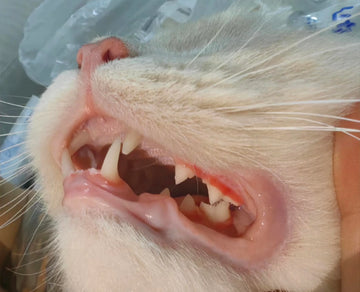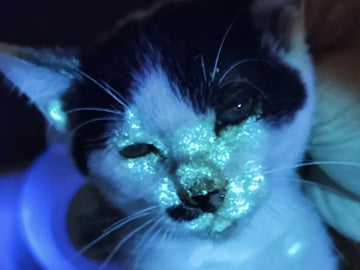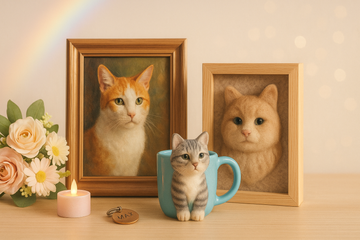Updated: October 2025 · Read time ~18–25 minutes
When my kitten was diagnosed with FIP (feline infectious peritonitis), he weighed barely three pounds, slept in corners, spiked intermittent fevers, and his belly ballooned almost overnight. We were told the word every cat parent dreads. Today, he’s over five pounds, zoomies restored, appetite fierce. This article is our path in plain English—what to watch for, how we confirmed the diagnosis, the treatment approach that fit U.S. rules, how we handled costs, and the small care habits that stacked the odds in our favor. If you’re reading this at 2 a.m. through tears: there’s real hope now. Take a breath. Let’s get practical.
1) Why FIP Is Dangerous (and Why Speed Matters)
FIP starts with a common feline coronavirus (FCoV) that mutates inside the cat and triggers an aggressive immune reaction. Untreated, the disease can spiral into fluid accumulation (wet FIP), organ inflammation (dry FIP), and sometimes eye or neurologic involvement. The risk is not just weight loss or lethargy—the danger is multi-organ damage and progressive decline. The good news: in 2025, with modern antiviral therapy guided by a licensed veterinarian, many cats survive and return to normal lives. The earlier you act, the fewer complications you’ll battle and the shorter your treatment may be.
2) Red-Flag Symptoms of FIP – Including Dry FIP (Often Missed Early)
FIP shows up in two main clinical forms: Wet (effusive) FIP and Dry (non-effusive) FIP. Many people (including me, at first) only associate FIP with a swollen belly, but that is only one form. Dry FIP is easier to miss because it often has subtle symptoms at first and no visible fluid build-up.
Wet FIP (Effusive) – Faster Progression, Easier to Notice
- Swollen belly from abdominal fluid (ascites)
- Trouble breathing if fluid enters the chest cavity
- Sudden weight loss + bony spine but round abdomen
- Persistent fever that doesn’t respond well to regular meds
- Lethargy and loss of appetite
This was my cat: classic wet FIP — fluid belly, fever, rapid decline. If your cat shows these symptoms, treat it as urgent.
Dry FIP (Non-effusive) – Slower, More Hidden, Easily Misdiagnosed
Dry FIP doesn’t usually produce fluid, so it’s often mistaken for anemia, immune disease, or even cancer at first. Look for a combination of systemic inflammation + organ involvement.
- Slow but progressive weight loss
- Chronic low appetite despite food changes
- Enlarged lymph nodes (neck, chest, groin)
- Kidney or liver abnormalities on bloodwork
- Eye inflammation (uveitis) – cloudy eyes, iris color changes
- Neurological signs – wobbly walking, seizures, hind leg weakness
Important: Dry FIP cats can suddenly develop effusion (fluid) later. Dry FIP is not “milder,” it’s just harder to spot earlier.
Shared Early Warning Signs (Any FIP Type)
Whole-body changes
- Lethargy, reduced activity, hiding more than usual
- Low appetite or sudden food refusal
- Chronic or intermittent fever
Digestive signs
- Vomiting or diarrhea
- Abdominal discomfort
- Unexplained weight loss
Appearance
- Rough or unkempt fur
- Sunken face/temples from muscle loss
- Poor coat and low body mass
Nervous system/eye signs
- Uneven pupils or eye cloudiness
- Head tremors, leg weakness, balance problems
- Behavioral changes or confusion
If you notice ANY combination of fever + weight loss + eye issues or wobbliness, ask your vet to screen for FIP immediately.
3) How to Confirm FIP in the U.S.: Tests & Decision Points
There isn’t a single blood test that screams “100% FIP.” It’s a pattern-recognition diagnosis—history, clinical signs, labwork, imaging, and ideally PCR on fluid or tissue.
Core labs & imaging
- CBC/Chemistry: inflammation, anemia of chronic disease, elevated total protein with high globulins and low albumin. Many vets watch the A:G ratio (albumin:globulin). Rough guide many clinicians use: <0.4 strongly suspicious, >0.8 less likely FIP, and 0.4–0.8 is a gray zone. Ratios alone don’t diagnose—context matters.
- Ultrasound/X-ray: looks for fluid in abdomen/chest, enlarged organs, thickened intestinal serosa or lymph nodes; helps guide fluid taps.
- Effusion analysis: wet FIP fluid tends to be yellow-straw, viscous, protein-rich. Rivalta can be supportive, not definitive. PCR on that fluid is more informative.
Specific testing
- RT-PCR for feline coronavirus on effusions (or tissue) raises confidence, especially alongside typical signs. A negative PCR doesn’t fully rule out FIP; clinicians synthesize all data.
- Ocular/neuro workups for dry FIP with eye/nerve signs: ophthalmic exam, sometimes aqueous/vitreous taps, neuro imaging, CSF analysis when appropriate.
How our decision looked
Young cat + classic signs + low A:G + ultrasound showing free fluid + straw-colored effusion with supportive analysis + positive PCR on effusion → our vet felt confident enough to initiate antiviral therapy quickly while we continued to monitor labs. That speed probably saved us a lot of pain later.
Not sure if it’s FIP or a simple tummy bug? Start here for supportive care basics while you arrange a vet visit: Cat Gastroenteritis Treatment Guide. If fever, fluid, or low A:G are present, prioritize FIP workup.
4) Treatment Options (U.S.-Appropriate) & Vet Partnership
In 2025, many U.S. veterinarians can legally prescribe compounded antiviral medications for FIP under specific federal guidance. Your path should be: diagnosis → prescription through a licensed DVM → medication dispensed by a reputable compounding pharmacy → scheduled rechecks. Please avoid gray-market sources; quality and dose consistency matter when your cat’s life depends on it.
Antivirals you’ll hear about (talk with your vet):
- GS-441524–based therapy (oral compounded forms): widely used by vets in 2024–2025 under enforcement discretion; dosing and duration vary by wet/dry/ocular/neuro form and weight. Many cats respond within days—fever breaks, appetite returns, energy improves.
- Remdesivir: a prodrug of GS; some clinicians use IV or other routes as part of an initiation protocol or for complex cases. Whether it fits your cat depends on access and specialist input.
- Molnupiravir (EIDD-2801/NHC): an oral antiviral some veterinarians consider in certain scenarios or as backup. Usage is evolving; your DVM will weigh risks/benefits and local regulations.
Typical framework (what ours looked like)
- Length: many cases run 8–12 weeks, with additional “consolidation” for ocular/neuro cases if needed.
- Rechecks: every 2–4 weeks for weight, temperature, appetite/energy, CBC/chemistry—including total protein and A:G. Imaging if fluid was present; eye/neurologic checks if those systems were involved.
- Support meds: liver support if enzymes rise; appetite support when needed; antibiotics only for documented secondary infections; fluids for dehydration; pain and anti-nausea therapies case-by-case.
Why prescription + reputable compounding pharmacy?
- Consistency: batch potency and stability are controlled and traceable.
- Safety & compliance: you stay inside U.S. legal/medical guardrails; vets can monitor and adjust confidently.
- Clinical oversight: rechecks determine if dosing needs adjustment or if the plan should pivot.

5) Daily Home Care: Feeding, Hydration, Stress Control
Food & gut comfort
- Small, frequent meals of easy-to-digest food; slowly step back to the regular diet.
- Use vet-approved probiotics if recommended; call your DVM if vomiting/diarrhea persists.
- Weigh weekly—objective numbers beat “looks better.”
Hydration & heat
- Offer multiple water stations; try pet fountains if your cat is picky.
- In hot climates or during summer trips, watch for lethargy + panting; cool rooms help recovery.
Stress & routine
- Quiet room, predictable schedule, gentle handling. Skip visitors for a few weeks.
- Pill routine: treat → dose → cuddle. Keep it short and positive.
For safety proofing your home while your cat recovers, start with our practical checklist: Cat Safety at Home.
6) Timeline, Costs & Milestones (My Real Numbers)
Every city and clinic is different; here’s our ballpark to help you plan.
| Phase | What We Did | Typical Items | Our Cost (USD) |
|---|---|---|---|
| Diagnosis week | ER visit + primary vet; labs, ultrasound, effusion tap + PCR | CBC/chem, A:G, imaging, fluid analysis, PCR | $600–$1,200 |
| Treatment (8–12 wks) | Daily/regular antivirals per vet; supportive meds as needed; rechecks q2–4 wks | Antiviral RX, liver support, anti-nausea, weigh-ins, lab panels | $1,500–$3,500+ |
| Consolidation & recovery | Diet upgrades, probiotics, final lab check, imaging PRN | Follow-up visit, chem/CBC, ultrasound if fluid was present | $200–$600 |
We tightened other expenses for a few months and said yes to the plan that promised the best shot. Zero regrets.
7) U.S. Holiday & Weekend ER Strategy (July 4, Thanksgiving, Christmas)
- Call ahead: holiday weeks mean longer waits. Ask about triage and average wait times before you drive.
- Map backups: save at least two 24/7 ERs in your area and one in the next town. Put numbers in your phone.
- Refill early: request medication refills at least one week before Independence Day, Thanksgiving, or Christmas closures.
- Travel smart: if you must travel, split doses into two labeled bags and bring paper copies of your latest labs and prescriptions.
8) FAQ: Relapse, Stopping Too Early, vs. Simple Gastroenteritis
What makes FIP dangerous compared with a routine stomach bug?
FIP is systemic and progressive—fever, fluid, organ/eye/neuro involvement. Gastroenteritis is usually self-limited GI upset. If your cat has persistent fever, fluid, weight loss, or a low A:G, treat it as urgent and pursue FIP workup.
How long until I see improvement?
Many cats brighten within days—fever drops and appetite returns first. Lab changes (like A:G) may take weeks. Don’t judge therapy by one day’s numbers; follow the plan and recheck.
Can I stop early once my cat looks “normal”?
Please don’t. Premature stops risk relapse. Your vet will decide the end point using symptoms, weight, labs, and imaging. Some ocular/neuro cases need longer consolidation.
What if antivirals upset the stomach?
Report promptly. Your vet may adjust timing, give with food, change formulation, or add anti-nausea support. Never change the dose yourself.
Could this just be gastroenteritis?
Maybe—if no fever, no fluid, good energy, and labs are reassuring. For supportive tips while you schedule a vet visit, see our Cat Gastroenteritis Treatment Guide.
9) Prevention & Environment: Lowering Future Risk
Immunity & stress
- Steady routines, slow introductions, reduce crowding if you have a multi-cat home.
- Clean litter boxes frequently; separate boxes for sick cats during recovery.
Hygiene
- Hand washing between cats; disinfect shared bowls and scoops.
- Keep carriers clean; avoid stressful travel until fully recovered.
Home safety
- Proof rooms against toxins and hazards; see Cat Safety at Home for a room-by-room checklist.
10) Printable Checklists: Vet Visit Pack & Home-Care Kit
Vet Visit Pack
- Timeline of symptoms (dates), temperature readings, daily appetite notes.
- Any videos of breathing effort, gait issues, or eye changes.
- Past records: vaccines, prior illnesses, medications/supplements and last doses.
Home-Care Kit
- Digital thermometer + lubricant; notebook for daily weight/temps.
- High-value food toppers for post-nausea appetite bumps.
- Probiotics if your vet okays; multiple water stations; soft blankets; a quiet recovery room.




